by Bruce Wells | May 6, 2024 | This Week in Petroleum History
May 7, 1920 – Halliburton founds Well Cementing Company in Oklahoma –
As mid-continent oil and gas discoveries continued, Erle Palmer Halliburton founded the Halliburton Company as an oilfield well service and cementing company. The Wilson, Oklahoma, venture succeeded his New Method Oil Cementing Company, established a year earlier during the Burkburnett oil boom in North Texas.
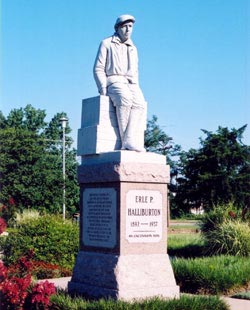
An Erle P. Halliburton statue was dedicated in 1993 in Duncan, Oklahoma.
In 1922, Halliburton patented an innovative “jet-cement” mixer that increased the speed and quality of the mixing process. By the end of the year, 17 Halliburton trucks were cementing wells in Texas, Oklahoma, Louisiana, and Arkansas. Cement injection protects the well casing, seals off water formations from the oil, and minimizes the danger of blowouts.
The company introduced cement pumps powered by truck motors (instead of steam from the rig boiler) and a device that allowed testing of a formation without setting casing. Halliburton was the first to offer self-contained cementing units operating under their own power. More advances in cementing technology followed.
Learn more in Halliburton cements Wells.
May 8, 1918 – Shreveport Gassers go Extra Innings
As baseball became America’s favorite pastime, the Texas League’s Shreveport Gassers played 20 innings against the Fort Worth Panthers before the game was declared a tie. The Gassers were just one of many oilfield-related teams in the National Association of Professional Baseball Leagues, today known as Minor League Baseball.
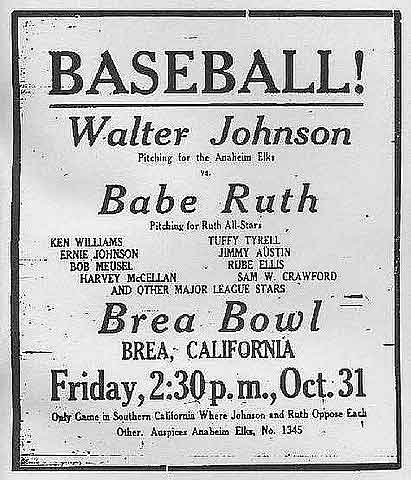
Former Olinda Oil Wells pitcher Walter Johnson joined Babe Ruth for a 1924 exhibition game at Brea, California.
At the time, the leagues’ 96 teams included the Okmulgee Drillers, the Tulsa Oilers, the Independence Producers, the Beaumont Exporters, the Corsicana Oil Citys, the Wichita Falls Spudders, and the Iola Gasbags. In Oklahoma oilfields, the Okmulgee Drillers for the first time in baseball history had two players who combined to hit 100 home runs in a single season of 160 games.
Learn more in Oilfields of Dreams.

May 8, 1920 – Burbank field discovered in Oklahoma
Drilling for natural gas 20 miles east of Ponca City, Oklahoma, the Kay County Gas Company’s Bertha Hickman No. 1 well revealed a giant oilfield. Marland Oil & Refining Company assumed control of the discovery well, which produced 150 barrels of oil a day from a depth of about 3,000 feet. The Burbank field would extend over 33 square miles, mostly in Osage County, and produce between 20 million barrels and 31 million barrels annually for the next four years.
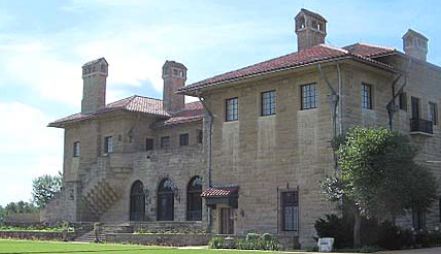
E.W. Marland in 1928 built his Ponca City mansion, now a museum. Fellow Oklahoman Will Rogers was a frequent guest.
With Oklahoma production booming since the Red Fork Gusher of 1901, independent producers agreed to using 10-acre well spacing for oil conservation purposes. Ernest W. Marland’s company also applied new seismographic technologies to discover the Tonkawa oilfield. Learn more about the Oklahoma governor (1935 to 1939) by visiting the Marland Estate in Ponca City.
May 9, 1863 – Confederate Cavalry raids Oilfield
A brigade of Confederate cavalry attacked a thriving oil town near the Ohio River in what would soon become West Virginia. Confederate Gen. William “Grumble” Jones led the cavalry attack on Burning Springs oilfield storage facilities containing thousands of barrels of oil.
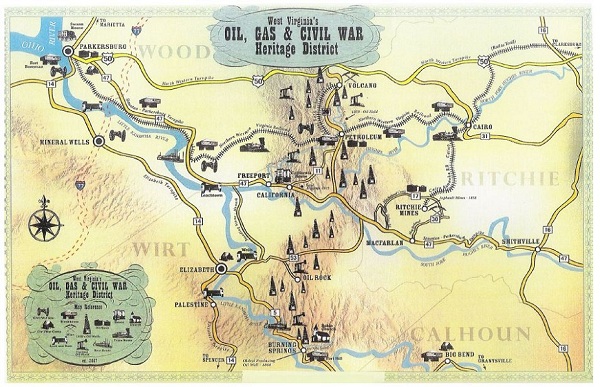
Rebels attacked the Burning Springs oilfield on the banks of the Little Kanawha River, just a few miles southeast of Parkersburg and the Ohio River. Heritage district map courtesy Oil & Gas Museum, Parkersburg, West Virginia.
The Confederate raid’s destruction and fire along the Kanawha River marked the first time an oilfield was targeted in war. About 1,300 Confederate troopers raided Burning Springs, destroying cable-tool drilling rigs and 150,000 barrels of oil.
Economic growth created by the early petroleum industry prior to the Civil War helped lead to statehood for West Virginia in June 1863. Almost a century earlier, George Washington had acquired 250 acres in the region because it contained natural oil seeps.
Learn more in Confederates attack Oilfield.

May 11, 1880 – Dresser patents Oil Well Device
Solomon R. Dresser of Bradford, Pennsylvania, patented a rubber “packer” for sealing downhole pressure in wells. The technology behind the patent (no. 227419) helped confine gas, “which enters the well from the lower rocks and utilize its force or pressure to expel the oil from the well.”
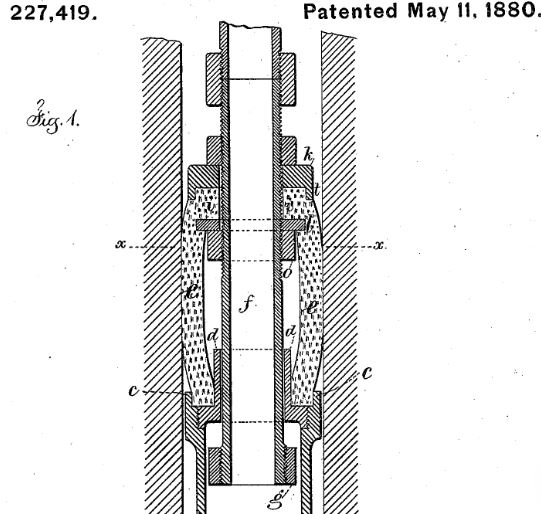
Detail from Solomon R. Dresser 1880 patent for a rubber “packer” to seal downhole pressure in wells.
With the success of his Dresser Cap Packer in the Bradford oilfield, the inventor founded the S.R. Dresser Manufacturing Company in 1885. Within one year he would patent a widely adopted pipeline coupling method using rubber for tight seals, which permitted long-range transmission of natural gas.
After expanding into manufacturing oilfield pumps, engines and compressors, Dresser’s company went public in 1928, moving its headquarters to Dallas in 1950. Dresser Industries merged with oilfield supply rival Halliburton for about $7.7 billion in stock in 1998.
May 12, 2007 – Two Oil Museums open in Oklahoma
ConocoPhillips opened petroleum museums in Ponca City and Bartlesville as part of the 2007 Oklahoma statehood centennial celebrations.
Exhibits at the Conoco Museum In Ponca City educate visitors about the company, which began in Utah as Continental Oil Company, a distributor of coal, grease, and kerosene. Continental Oil merged with Ponca City-based Marland Oil Company in 1929; Conoco merged with Phillips Petroleum Company of Bartlesville in 2002.

Conoco, founded in 1875 as the Continental Oil and Transportation Company, delivered kerosene to retail stores in Ogden, Utah. A circa 1880s tank wagon now welcomes visitors to the Conoco Museum. Photo by Bruce Wells.
Frank and L.E. Phillips drilled 81 wells without a “dry hole” prior to establishing their company in 1917. The Phillips Petroleum Company Museum preserves the their oil patch legacy, the history of high-octane gasoline, and the company’s thousands of U.S. patents — including for plastic products like Marlex. Frank Phillips served as president until 1938.
Learn more in ConocoPhillips Petroleum Museums.
Recommended Reading: Erle P. Halliburton, Genius with Cement (1959); Oil in Oklahoma
(1959); Oil in Oklahoma (1976); Textile League Baseball: South Carolina’s Mill Teams, 1880-1955
(1976); Textile League Baseball: South Carolina’s Mill Teams, 1880-1955 (2004); The Civil War and Northwestern Virginia
(2004); The Civil War and Northwestern Virginia (2004); Conoco: 125 Years of Energy
(2004); Conoco: 125 Years of Energy (2000); Phillips, The First 66 Years
(2000); Phillips, The First 66 Years (1983). Your Amazon purchase benefits the American Oil & Gas Historical Society. As an Amazon Associate, AOGHS earns a commission from qualifying purchases.
(1983). Your Amazon purchase benefits the American Oil & Gas Historical Society. As an Amazon Associate, AOGHS earns a commission from qualifying purchases.
_______________________
The American Oil & Gas Historical Society preserves U.S. petroleum history. Become an AOGHS annual supporting member and help maintain this energy education website and expand historical research. Contact bawells@aoghs.org. Copyright © 2024 Bruce A. Wells. All rights reserved.
by Bruce Wells | Apr 29, 2024 | This Week in Petroleum History
April 30, 1929 – Marland Oil and Continental Oil become Conoco –
After discovering several Oklahoma oil and gas fields, Marland Oil Company acquired Continental Oil Company to create a network of service stations in 30 states. Future Oklahoma Governor Ernest W. Marland founded Marland Oil in 1921; Continental Oil Company was founded in 1875 in Utah, where it refined oil into kerosene.

After Continental Oil and Marland Oil combined in 1929, the new company used this logo until 1970.
Headquartered in Ponca City, the new company retained the name of Continental Oil, but adopted the well-known Marland red triangle trademark, replacing the “Marland Oils” text with “Conoco.” The company merged with Phillips Petroleum (first incorporated in 1917), to become ConocoPhillips in 2002.
Learn more by visiting the ConocoPhillips Petroleum Museums.
April 30, 1955 – Landmen form Trade Association
The American Association of Professional Landmen (AAPL) organized as a petroleum landmen trade association in Fort Worth, Texas. AAPL members research records to determine well ownership, locate mineral and land owners, and negotiate oil and natural gas leases, trades and contracts. With 12,000 members, AAPL assists in compliance with state and federal regulations, according to the association, which will host its 70th annual meeting this June in Boston.

May 1, 1860 – First West Virginia Oil Well
As the Civil War approached, Virginia’s petroleum industry began when John Castelli ”Cass” Rathbone completed an oil well near Burning Springs Run in what today is West Virginia. His well — drilled using a spring pole — reached 300 feet and began producing 100 barrels of oil a day.
Rathbone drilled more wells in the valley of the Little Kanawha River southwest of Parkersburg. It was the first petroleum boom to take place outside the Pennsylvania oilfields, revealed by the first U.S. well at Titusville a year earlier.
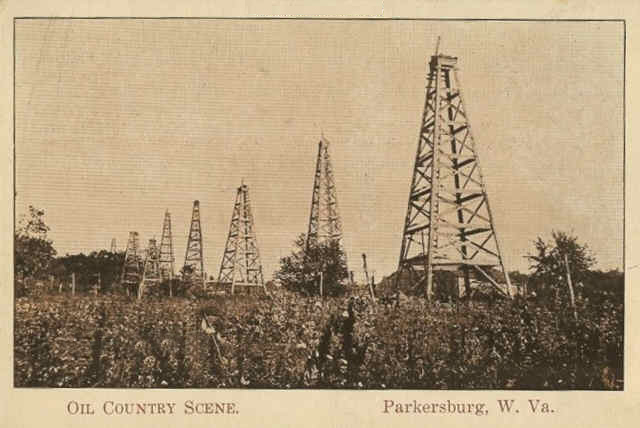
Following the 1860 oil discovery at Burning Springs, Appalachian drillers applied cable-tool technologies to drill deeper. Circa 1870 photo courtesy West Virginia Humanities Council.
By the end of 1860, the “Burning Springs Oil Rush” resulted in more than 600 oil leases registered in the Wirt County courthouse. Warehouses were built along the Little Kanawha River, which reached the Ohio River at Parkersburg.
“These events truly mark the beginnings of the oil and gas industry in the United States,” proclaimed West Virginia historian David McKain in 1994, adding that the region’s oil wealth helped bring about statehood in June 1863. Many of the new state’s politicians were “oil men — governor, senator and congressman — who had made their fortunes at Burning Springs.”
Visit West Virginia’s oil and gas museum in downtown Parkersburg.
May 1, 1916 – Harry Sinclair founds Sinclair Oil & Refining
Harry Ford Sinclair combined several depressed oil properties, five small refineries and many untested leases — all acquired at bargain prices. He began with $50 million in assets and borrowed another $20 million to form Sinclair Oil & Refining Corporation.
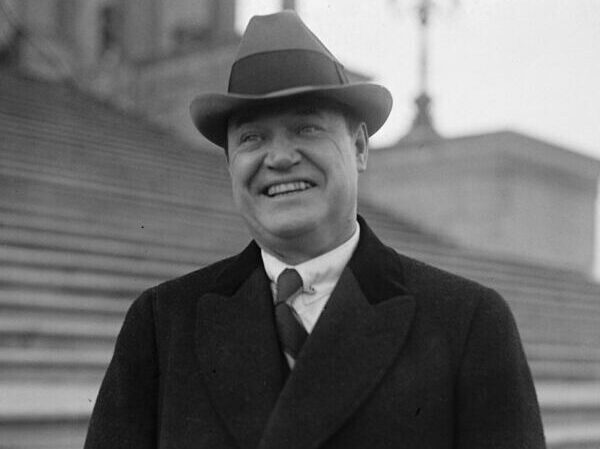
Sinclair Oil & Refining Corporation founder Harry Sinclair on the U.S. Capitol steps in January 1923. Photo Courtesy Library of Congress.
In its first 14 months, Sinclair’s New York-based company produced six million barrels of oil for a net income of almost $9 million ($258 million in 2024 dollars). The company’s petroleum refining capacity grew to 150,000 barrels of oil a day in 1932.
Sinclair was implicated in the Teapot Dome Scandal, which led to the 1929 conviction of Interior Secretary Albert Fall, but his company went on to become one of the oldest continuous names in the U.S. petroleum industry. The marketing icon Sinclair Oil dinosaur appeared as an exhibit at the 1933-1934 World’s Fair in Chicago. Sinclair died in 1956 at age 80.

May 1, 1931 – Railroad Commission limits East Texas Oil Production
The first proration order from the Texas Railroad Commission (RRC) for the giant East Texas oilfield took effect after excessive production following the Daisy Bradford No. 3 well one year earlier caused a massive collapse in oil prices. With hundreds of wells producing almost one million barrels per day, oil prices had fallen to as low as 10 cents a barrel. The commission’s order — unpopular with independent producers but enforced by Texas Rangers — limited production and stabilized prices.
May 1, 2001 – Oklahoma Plaza honors Oil Pioneers
The Conoco Oil Pioneers of Oklahoma Plaza was dedicated at the Sam Noble Museum at the University of Oklahoma, Norman. Thomas B. Slick, who discovered Oklahoma’s giant Cushing oilfield in 1912, is among those honored.

Thomas B. Slick relief at Conoco Oil Pioneers outdoor plaza at the Sam Noble Museum, University of Oklahoma, Norman.
“The history of the state of Oklahoma is inextricably linked with the remarkable history of the oil industry,” proclaimed Conoco Chairman Archie Dunham. “The individuals identified here are true Oklahoma oil pioneers in that their endeavors were most significant in the development of the oil and gas industry in this very young state.”
Learn more in Oklahoma’s King of the Wildcatters,
May 2, 1921 – Oil discovered in Texas Panhandle
Following a series of discoveries revealing the giant Hugoton natural gas field in the Texas Panhandle, a well drilled in Carson County found an oilfield instead. Gulf Oil Company completed its wildcat well on the 6666 (the “Four Sixes”) Ranch of S.B. Burnett several miles east of the natural gas wells. The discovery attracted major exploration and oilfield service companies to Amarillo. In 1926, a giant oilfield was discovered to the northeast by Asa Phillip “Ace” Borger, who founded the oil boom town of Borger. Learn more at the Hutchinson County Historical Museum.
May 3, 1870 – Lantern with Two Spouts patented
Jonathan Dillen of Petroleum Centre, Pennsylvania, received a patent for his “safety derrick lamp” — a two-wicked lantern that would become known as the “Yellow Dog” in America’s earliest oilfields. Dillen designed his device “for illuminating places out of doors, especially in and about derricks, and machinery in the oil regions, whereby explosions are more dangerous and destructive to life and property than in most other places.”
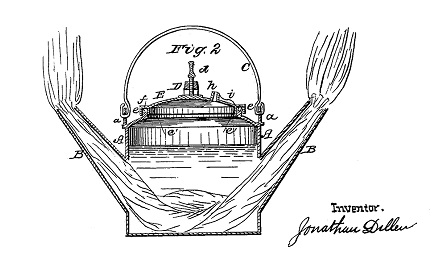
Patented in 1870, a popular two-wicked oilfield derrick lamp would become known as the “yellow dog.”
“My improved lamp is intended to burn crude petroleum as it comes from the wells fresh and gassy,” he added. How the once widely used lamp got its name has remained a mystery, but some say the two burning wicks resembled a dog’s glowing eyes at night.
Learn more in Yellow Dog – Oilfield Lantern.

May 4, 1869 – Offshore Drilling Platform Design patented
The first U.S. patent for an offshore drilling rig was issued to Thomas Rowland, owner of Continental Iron Works in Greenpoint, New York, for his “submarine drilling apparatus.” His remarkably advanced platform included a fixed, working platform for drilling in a water depth of up to 50 feet.
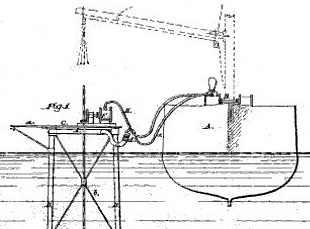
Thomas Rowland’s design for an offshore drilling platform with telescoping legs was ahead of its time.
Rowland’s anchored, four-legged tower concept would be adapted for modern platforms. His Continental Iron Works also became a world leader in gas fittings, welding, and oil tank design and construction. The American Society of Civil Engineers in 1882 issued its first Thomas Fitch Rowland Prize. which is still annually awarded.
Learn more in Offshore Rig Patent.
May 5, 1889 – Construction begins on Largest U.S. Refinery
Near Chicago, on the southern shore of Lake Michigan, Standard Oil Company began construction of a 235-acre refinery complex using advanced processes. A newly patented technology would allow the Whiting, Indiana, refinery to process sulfurous “sour crude” from Lima, Ohio, oilfields. The oil would be transported on company-controlled railroads. The giant refinery (now operated by BP) originally produced high-quality kerosene for lamps. BP completed a multi-year, multi-billion dollar modernization project at the refinery in 2013.
Learn more in Standard Oil Whiting Refinery.
May 5, 1907 – A Marker to North Texas Petroleum History
Outside Oil City (today Petrolia),Texas, the Clayco Oil & Pipe Line Company completed its Lochridge No.1 well, “site of the first gas well in Texas,” according to a granite marker that credits local rancher J.W. Lochridge for the discovery east of Wichita Falls.
“This discovery marked the beginning of intensive development of the gas industry in Texas,” the marker explains, adding that a 1901 oil well in what proved to be the Henrietta-Petrolia field had disappointed Lochridge.

Clayco Oil & Pipe Line Company commemorated its 1907 discovery in North Texas with a marker that has endured near Highway 148 south of Petrolia.
As a 2016 article in North Texas Farm & Ranch explained, “Lochridge was disappointed because he needed water for his livestock. He found a use for the oil, using it in his dipping vats to rid his cattle of parasites.”
The Clayco Oil & Pipe Line Company marker in the Henrietta-Petrolia field acknowledges Lone Star Gas Company for constructing the state’s first large-diameter natural gas pipeline in 1920 to Fort Worth and Dallas. Lone Star Gas became Enserch Corporation in 1975.

_______________
Recommended Reading: Where it All Began: The story of the people and places where the oil & gas industry began: West Virginia and southeastern Ohio (1994); “King of the Wildcatters:” The Life and Times of Tom Slick, 1883-1930
(1994); “King of the Wildcatters:” The Life and Times of Tom Slick, 1883-1930 (2004). The Extraction State, A History of Natural Gas in America (2021); Erle P. Halliburton: Genius with Cement
(2004). The Extraction State, A History of Natural Gas in America (2021); Erle P. Halliburton: Genius with Cement (1959); Your Amazon purchase benefits the American Oil & Gas Historical Society. As an Amazon Associate, AOGHS earns a commission from qualifying purchases.
(1959); Your Amazon purchase benefits the American Oil & Gas Historical Society. As an Amazon Associate, AOGHS earns a commission from qualifying purchases.
_______________
The American Oil & Gas Historical Society (AOGHS) preserves U.S. petroleum history. Please become an AOGHS annual supporter and help maintain this energy education website and expand historical research. For more information, contact bawells@aoghs.org. Copyright © 2024 Bruce A. Wells. All rights reserved.
by Bruce Wells | Apr 22, 2024 | This Week in Petroleum History
April 22, 1920 – Natural Gas Well leads Arkansas Discoveries –
Although natural gas was first discovered in 1887 at Fort Smith, the first commercial production began in southern Arkansas with a well completed southeast of El Dorado. Drilled to a depth of almost 2,250 feet, the well produced up to 60 million cubic feet of natural gas a day and showed signs of oil from the Nacatoch formation sandstone. The first Arkansas oil wells arrived one year later at El Dorado and at Smackover in 1922.
April 22, 1926 – Osage Oil Lease Auctioneer Statue dedicated
A statue commemorating the friendship between oil and gas lease auctioneer Colonel E.E. Walters and Osage Indian Chief Baconrind (phonetically, Wah-she-hah) was dedicated in Walters’ hometown of Skedee, Oklahoma. Beginning in 1912, Colonel Elmer Ellsworth Walters (his real name) and the popular Chief of the Osage Nation raised millions of dollars for the tribe from mineral lease sales.
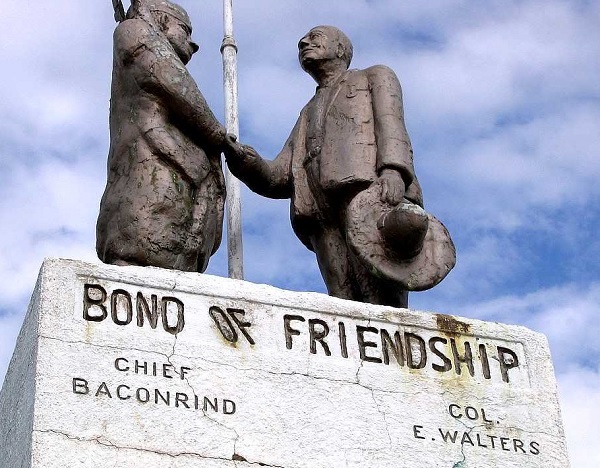
The town of Skedee, Oklahoma, has declined in population, but its 1926 statue of a famed auctioneer and Osage chief remains. Photo by Bruce Wells.
The auctions took place beneath an elm tree at the Tribal Council House in Pawhuska, where crowds gathering to witness bidding from Frank Phillips, E.W. Marland and William Skelly. The Skedee unveiling revealed “painted bronze” statues of Walters and the Chief Baconrind shaking hands on a sandstone base.
Learn more in Million Dollar Auctioneer.

April 22, 1930 – Marland unveils Pioneer Woman
One block from his mansion in Ponca City, Ernest Whitworth “E.W.” Marland unveiled The Pioneer Woman statue, his gift to the state to honor the role of women who settled there. A Pioneer Woman Museum opened nearby in 1958.

More than 40,000 gathered in Ponca City for the unveiling of The Pioneer Woman, a 17-foot bronze statue. Photo courtesy Oklahoma Historical Society.
“Marland invited sculptors to submit competitive designs in the form of small models,” notes the Oklahoma Historical Society (OHS). “The models were exhibited across the nation and 750,000 people cast their vote.” The 17-foot bronze cast was erected at a cost of $300,000.
Marland had lost a fortune in the Pennsylvania oilfields during the panic of 1907 before founding Marland Oil in Ponca City in 1917. An early advocate of using seismography and core drilling for finding oil, by 1920 Marland’s company controlled an estimated 10 percent of the world’s oil production.
April 22, 1964 – Sinclair Dinoland returns to New York World’s Fair
Continuing its successful marketing campaign begun in the 1930s, Sinclair Oil opened a Dinoland pavilion at the 1964-1965 New York World’s Fair. The exhibition of giant, fiberglass dinosaurs proved a hit with the 50 million people attending the fair. The first Sinclair Oil Dinoland, which attracted crowds to the Texas Centennial Exposition in 1936, had been expanded for the 1939-1940 New York World’s Fair. Following the latest New York exhibition, the 70-foot green “Dino” and eight other dinosaurs traveled to make stops at shopping centers, delighting children in 25 states.
April 23, 1878 – Oil Exchange Building opened in Pennsylvania
The Oil Exchange of Oil City, Pennsylvania, opened a new, $100,000 brick building on Seneca Street. Independent producers began meeting there to trade oil and pipeline certificates. They had earlier gathered at local hotels or along Oil City’s Centre Street, then known as the “Curbside Exchange.”
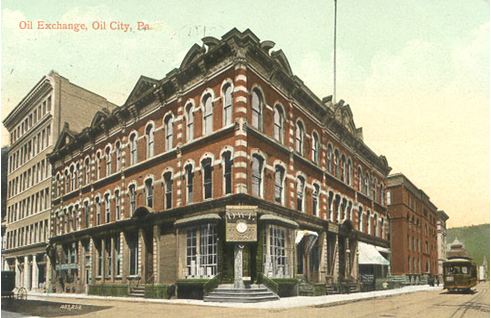
By 1877, Pennsylvania oil companies had created the third largest financial exchange of any kind in America, behind only New York and San Francisco.
Before the 1870s, most Pennsylvania oil buyers had taken on-site delivery of oil in wooden barrels they provided themselves. A rapidly growing oil pipeline infrastructure created the need for a place to trade certificates as oil commerce expanded. The Standard Oil Company of New Jersey would bring an end to Pennsylvania’s highly speculative oil-trading markets.
Learn more in End of Oil Exchanges.

April 24, 1911 – Magnolia Petroleum founded
The Magnolia Petroleum Company was founded as an unincorporated joint-stock association — a consolidation of several companies, the first of which began in 1898 as a small refinery in Corsicana during the first Texas oil boom.

Magnolia Petroleum would merge with Socony Mobil Oil in the 1930s and replace its flower with the “Flying Pegasus” logo.
As Magnolia Petroleum established service stations in southwestern states, Standard Oil Company of New York (Socony) began acquiring the company in 1925 before merging with the Vacuum Oil Company in 1931. The new company, Socony-Vacuum Oil — the future Mobil Oil — included stations in 20 states operated by Magnolia Petroleum, headquartered in a Dallas skyscraper. Magnolia adopted the Socony-Vacuum Oil Pegasus logo, which began rotating atop the building in 1934.
Learn more in Mobil’s High-Flying Trademark.
April 24, 1917 – Petroleum Product for Eyelashes trademarked
Tom Lyle Williams, doing business in Chicago as Maybell Laboratories, trademarked the name Lash-Brow-Ine as a mascara and “preparation for stimulating the growth of eyebrows and eyelashes.” Two years earlier, Williams had watched his sister Mabel perform what she called “a secret of the harem,” mixing petroleum jelly with coal dust and applying it to her eyelashes.
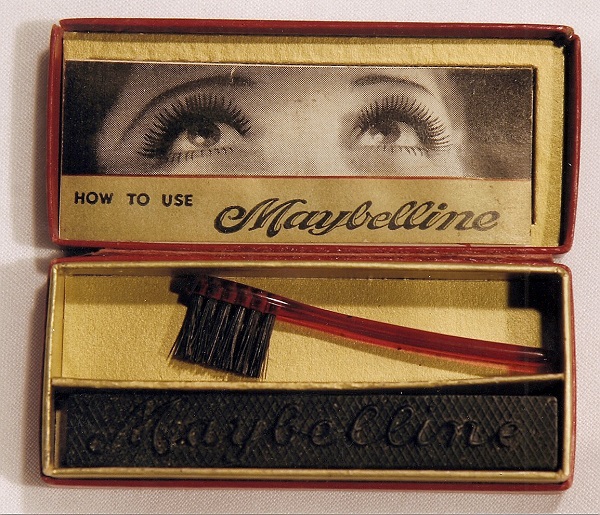
Women once used toothpicks to mix lamp black with Vaseline. By the 1930s, Maybelline mascara was available at local five-and-dime stores. Photo courtesy Sharrie Williams.
The mascara’s key ingredient, Vaseline, had been patented in 1872 by Robert Chesebrough, a young chemist in Brooklyn, New York. Williams began selling tins of Mabel’s mixture by mail-order catalog, calling it “lash-brow-ine.” With sales exceeding $100,000 by 1920, Williams renamed the mascara Maybelline in honor of his sister, who worked with him in his Chicago office.
Learn more in The Crude Story of Mabel’s Eyelashes.

April 25, 1865 – Civil War Veteran patents Well Torpedo
Civil War veteran Col. Edward A.L. Roberts of New York City received the first of his many patents for an “Improvement in Exploding Torpedoes in Artesian Wells.” The invention used controlled downhole explosions “to fracture oil-bearing formations and increase oil production.”
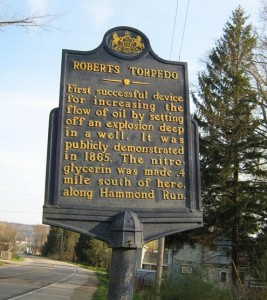
A Pennsylvania historical marker notes the 1865 first demonstration of the invention of Union Col. E.A.L. Roberts.
Roberts torpedoes were filled with gunpowder, lowered into wells, and ignited by a weight dropped along a suspension wire to percussion caps. In later models, nitroglycerin replaced gunpowder. Before the well torpedo’s invention, many early wells in the new oil regions of Pennsylvania, New York, and West Virginia often produced limited amounts of oil.
With its exclusive patent licenses, the Roberts Petroleum Torpedo Company charged up to $200 per torpedo “shoot” and a one-fifteenth royalty. Seeking to avoid the expense, unlicensed practitioners operated at night with their own explosive devices, reportedly leading to the term “moonlighter.”
Learn more in Shooters – A “Fracking” History.
April 26, 1947 – Oil Industry promoted on Radio
For the first time since its establishment in 1919, the American Petroleum Institute launched a national advertising campaign. “The theme of the drive is that the petroleum industry is a modern and progressive one, and is now turning out the best products in its history,” noted The Billboard.
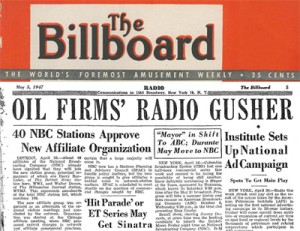
Founded in 1919 in New York City, API moved its headquarters to the nation’s capital in 1929.
“Radio this week struck real pay dirt as a ‘Gusher’ will come mainly from expansion of current air time on spot local or regional levels by the thousands of petroleum and related corporations,” proclaimed the weekly publication. API today is a Washington, D.C.-based lobbying organization representing major U.S. petroleum companies. It issues industrywide recommended practices, “to promote the use of safe equipment and proven engineering.”

April 27, 1966 – Ariel Corporation founded
After receiving a degree in mechanical engineering in 1954, former eighth-grade teacher Jim Buchwald founded Ariel Corporation in Mount Vernon, Ohio. “With little money to pay for a facility to house the tools, a room in the basement of the Buchwald family home is cleaned up,” according to the Ariel website.
Buchwald bought a lathe, a small hand-cranked rotary table and a vertical drill for manufacturing valves. “This room becomes the first Ariel machine shop, with an adjoining room functioning as Ariel’s first official engineering department.”

Jim Buchwald with Ariel’s prototype compressor after it has completed a 10-hour run test. Photo courtesy Ariel.
By 1968, Buchwald had built a prototype gas compressor that ran at the unprecedented speed of 1,800 RPM. His Ohio machine shop soon transitioned into a manufacturing facility, and Buchwald named the company after his favorite 1948 Ariel motorcycle. His company has become one of the world’s largest manufacturers of reciprocating gas compressors.
_______________________
Recommended Reading: The Osage Oil Boom (1989); The Prize: The Epic Quest for Oil, Money & Power (1991); Historic Photos of Texas Oil
(1989); The Prize: The Epic Quest for Oil, Money & Power (1991); Historic Photos of Texas Oil (2012); The Maybelline Story: And the Spirited Family Dynasty Behind It
(2012); The Maybelline Story: And the Spirited Family Dynasty Behind It (2010); The Boom: How Fracking Ignited the American Energy Revolution and Changed the World
(2010); The Boom: How Fracking Ignited the American Energy Revolution and Changed the World (2015); Michigan Yesterday & Today (2009); The Seven Sisters: The great oil companies & the world
(2015); Michigan Yesterday & Today (2009); The Seven Sisters: The great oil companies & the world (1975). Your Amazon purchase benefits the American Oil & Gas Historical Society. As an Amazon Associate, AOGHS earns a commission from qualifying purchases.
(1975). Your Amazon purchase benefits the American Oil & Gas Historical Society. As an Amazon Associate, AOGHS earns a commission from qualifying purchases.
_______________________
The American Oil & Gas Historical Society (AOGHS) preserves U.S. petroleum history. Become an AOGHS annual supporting member and help maintain this energy education website and expand historical research. For more information, contact bawells@aoghs.org. Copyright © 2024 Bruce A. Wells. All rights reserved.
by Bruce Wells | Apr 15, 2024 | This Week in Petroleum History
April 15, 1857 – First Natural Gas Company incorporated –
Two years before the first U.S. oil well in Titusville, Pennsylvania, the Fredonia Gas Light and Water Works Company incorporated in Fredonia, New York, where a well drilled by local machinist and gunsmith William A. Hart supplied natural gas to a mill as early as 1825. Hart found the gas after drilling three wells, according to historian Lois Barris.
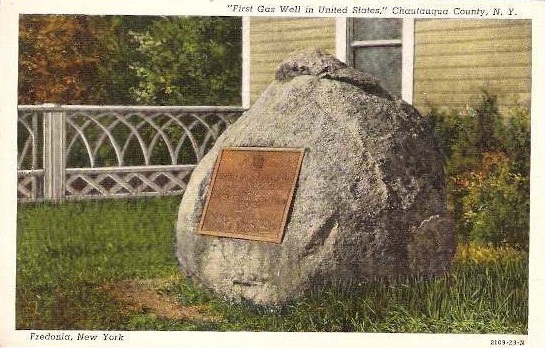
Circa 1950 souvenir postcard of a bronze plaque on a boulder in Fredonia, New York, dedicated in 1925 by the Daughters of the American Revolution.
“He left a broken drill in one shallow hole and abandoned a second site at a depth of forty feet because of the small volume of gas found,” Barris noted in her “Fredonia Gaslight and Waterworks Company.” The third well produced natural gas from 70 feet beneath “a bubbling gas spring in the bed of a creek.” Constructing a simple gasometer, Hart “proceeded to pipe and market the first natural gas sold in this country.”
As other communities adopted public lighting burning gas made from coal — manufactured gas street lamps began illuminating Baltimore in 1817 — Fredonia Gas Light and Water Works built the first U.S. natural gas pipeline network.

April 15, 1897 – Birth of Oklahoma Oil Industry
With a crowd gathered at the Nellie Johnstone No. 1 well near Bartlesville in Indian Territory, George Keeler’s stepdaughter dropped a “go devil” that set off a downhole canister of nitroglycerin. The resulting gusher heralded the start of Oklahoma’s oil and natural gas industry.
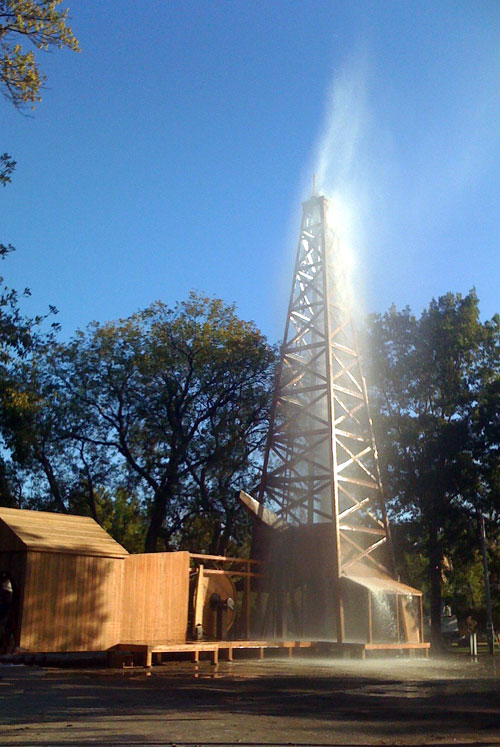
A 2017 water gusher demonstration of the Nellie Johnstone No. 1 replica in Discovery One Park, Bartlesville, Oklahoma.
Drilling had begun in January 1897, the same month that Bartlesville incorporated with a population of about 200 people. Four months later, at 1,320 feet, the Nellie Johnstone No.1 well (named for partner William Johnstone’s six-year-old daughter) showed its first signs of oil.
Although there had been earlier marginal producers, including a Cherokee Nation 1890 oil well, the Johnstone well revealed the Bartlesville-Dewey field, ushering in a commercial petroleum era for the territory. By the time of statehood in 1907, Oklahoma would lead the world in oil production.
An 84-foot derrick in Discovery One Park helps educate visitors about Oklahoma’s petroleum industry. The surrounding land was donated by Nellie Johnstone Cannon, descendant of a Delaware chief. Learn more in First Oklahoma Oil Well.
April 16, 1855 – Yale Scientist sees Value in Rock Oil
Yale chemist Benjamin Silliman Jr. reported Pennsylvania “rock oil” could be distilled into a high-quality illuminating oil. The professor’s “Report on Rock Oil or Petroleum” convinced a businessman George Bissell and a group of New Haven, Connecticut, investors to finance Edwin Drake to drill where Bissell had found oil seeps in northwestern Pennsylvania.
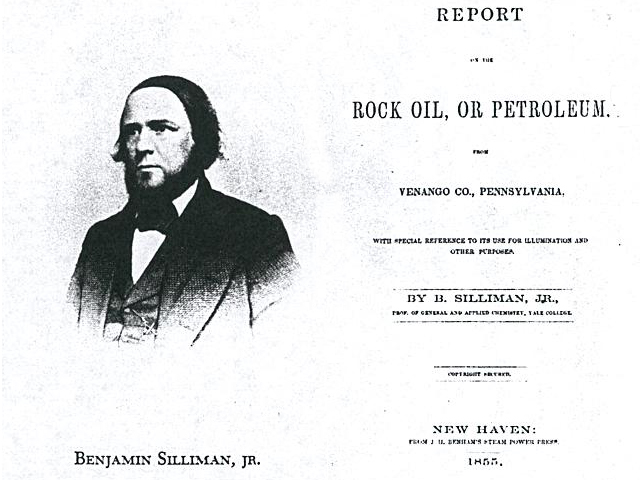
A Yale chemist’s 1855 report about oil’s potential as an illuminant would lead to America’s first commercial well four years later.
“Gentlemen,” Silliman wrote, “it appears to me that there is much ground for encouragement in the belief that your company have in their possession a raw material from which, by simple and not expensive processes, they may manufacture very valuable products.”
Silliman’s conclusion that the popular lamp fuel kerosene could be distilled from oil as readily as coal led to the first U.S. commercial oil well four years later.

April 16, 1920 – First Arkansas Oil Well
Col. Samuel S. Hunter of the Hunter Oil Company of Shreveport, Louisiana, completed the first oil well in Arkansas. His Hunter No. 1 well had been drilled to 2,100 feet. Natural gas was discovered a few days later by Constantine Oil and Refining Company north of what would become the El Dorado field in Union County.

The Arkansas Museum of Natural Resources is just north of El Dorado.
Although Col. Hunter’s oil well yielded only small quantities, his discovery was followed by a January 1921 gusher — the S.T. Busey well — in the same field. These wells, which made headlines, launched the state’s petroleum industry, according to the Arkansas Museum of Natural Resources.
Hunter would sell his original lease of 20,000 acres to Standard Oil Company of Louisiana for more than $2.2 million.
Learn more in First Arkansas Oil Wells.
April 17, 1861 – Oil Well Fire Tragedy in Pennsylvania
The lack of technologies for controlling wells led to a fatal oil well fire at Rouseville, Pennsylvania. Among the 19 people killed was leading citizen Henry Rouse, who subleased the land along Oil Creek. When his well erupted oil from a depth of 320 feet, the good news had attracted most Rouseville residents.
“Henry Rouse and the others stood by wondering how to control the phenomenon,” noted the local newspaper. Then the gusher erupted into flames, perhaps ignited by a steam-engine boiler.

“Burning Oil Well at Night, near Rouseville, Pennsylvania,” a painting by James Hamilton, circa 1861, at the Smithsonian American Art Museum, Washington, D.C.
The oilfield tragedy near Titusville would be overshadowed by the Civil War, but it was immortalized in 1861 by Philadelphia artist James Hamilton’s “Burning Oil Well at Night, near Rouseville, Pennsylvania,” which was added to the Smithsonian American Art Museum collection in 2017.
Learn more in Fatal 1861 Rouseville Oil Well Fire.

April 17, 1919 – North Texas Burkburnett Boom grows
Another drilling boom began in Wichita County, Texas, when the Bob Waggoner Well No. 1 well began producing 4,800 barrels of oil a day. One year earlier, a well on the Burkburnett farm of S.L. Fowler had brought hundreds of drillers to the Red River town. The county had been producing oil since 1912, when a shallow well drilled for water found oil instead.
A Burkburnett historical marker notes the 1919 oil discovery, “became known as the Northwest Extension Oilfield, comprised of approximately 27 square miles on the former S. Burk Burnett Wild Horse Ranch.” The marker adds that “the area was suddenly thick with oil derricks.”
Learn more in Boom Town Burkburnett.
April 18, 1939 – Patent for perforating Well Casing
Ira McCullough of Los Angeles patented a multiple bullet-shot casing perforator and mechanical firing system. He explained the object of his oilfield invention was “to provide a device for perforating casing after it has been installed in a well in which projectiles or perforating elements are shot through the casing and into the formation.”
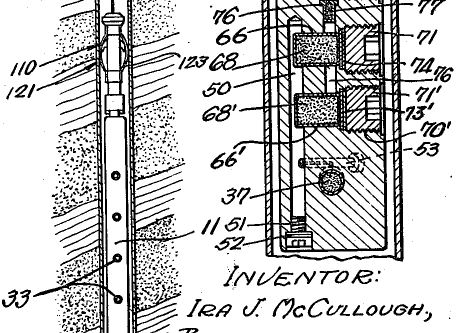
Ira McCullough’s 1937 patent drawing for perforating wells.
The innovation of simultaneous firing from several levels in the borehole greatly enhanced the flow of oil. McCullough’s device included a “disconnectable means” that rendered percussion inoperative until the charges were lowered into the borehole, acting as “a safeguard against accidental or inadvertent operation.”
Another inventor, Henry Mohaupt, in 1951 would use World War II anti-tank technology to improve the concept by using a conically hollowed-out explosive for perforating wells.
Learn more in Downhole Bazooka.
April 19, 1892 – First U.S. Gasoline Powered Automobile
Brothers Charles and Frank Duryea test drove a gasoline powered automobile they had built in their Springfield, Massachusetts, workshop. Considered the first model to be regularly manufactured for sale in the United States, 13 were produced by the Duryea Motor Wagon Company.

The Duryea brothers (above) built their cars in Springfield, Massachusetts.
The brothers sold their first Duryea motor wagon in March 1918. Two months later, a motorist driving a Duryea in New York City hit a bicyclist — reportedly America’s first auto traffic accident. By the time of the first U.S. automobile show in November 1900 at Madison Square Garden, of the 4,200 automobiles sold in the United States, gasoline powers less than 1,000.

April 20, 1875 – Improved Well Pumping Technology
Pumping multiple wells with a single steam engine boosted efficiency in early oilfields when Albert Nickerson and Levi Streeter of Venango County, Pennsylvania, patented their “Improvement In Means For Pumping Wells.” The new technology used a system of linked and balanced walking beams to pump oil wells.

U.S. oilfield technologies advanced in 1875 with an “Improvement In Means For Pumping Wells.”
“By an examination of the drawing it will be seen that the walking-beam to well No. l is lifting or raising fluid from the well. Well No. 3 is also lifting, while at the same time wells 2 and 4 are moving in an opposite direction, or plunging, and vice versa,” the inventors explained. Their system was the forerunner of rod-line (or jerk line) eccentric wheel systems that operated into the 20th century using iron rods instead of rope and pulleys.
Learn more in All Pumped Up – Oilfield Technology.
April 20, 1892 – Prospector discovers Los Angeles City Oilfield
The giant Los Angeles oilfield was discovered when a struggling prospector, Edward Doheny, and his mining partner Charles Canfield drilled into the tar seeps between Beverly Boulevard and Colton Avenue. Their well produced about 45 barrels of oil a day.

Artfully camouflaged petroleum production continues today in downtown Los Angeles. Edward Doheny discovered the oilfield in 1892. Photo courtesy the Center for Land Use Interpretation, Culver City, California.
Although the first California oil well had been drilled after the Civil War, Doheny’s 1892 discovery near present-day Dodger Stadium launched California’s petroleum industry. In 1897, about 500 Los Angeles City wells pumped more than half of the state’s annual production of 1.2 million barrels of oil. By 1925, California supplied half of all the world’s oil.
Learn more in Discovering Los Angeles Oilfields.
April 20, 2010 – Deepwater Horizon Gulf of Mexico Disaster
At 10 a.m., while completing a well in the Macondo Prospect, 50 miles off the Louisiana coast, the Deepwater Horizon exploded and sank, killing 11 and injuring another 17 workers. An estimated 3.2 million barrels of oil flowed into the Gulf of Mexico after the platform’s 400-ton blowout preventer failed, resulting in the largest accidental marine oil spill in U.S. history.
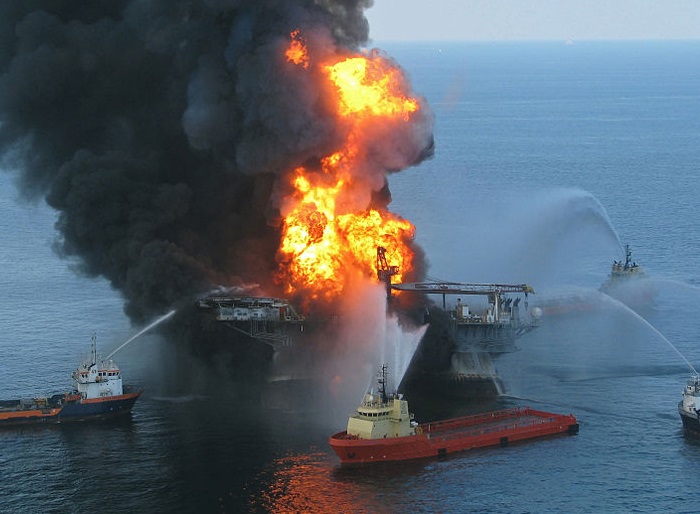
The April 2010 Deepwater Horizon explosion and fire killed 11 and injured 17 workers. USGS Photo.
Six months earlier at another site, the advanced, semi-submersible drilling rig had set a world record for the deepest offshore well (35,050 feet vertical depth in 4,130 feet of water). When the Macondo Prospect well was capped in mid-July, a National Commission on the Deepwater Horizon Oil Spill and Offshore Drilling launched an eight-month investigation. The commission released its final report on January 11, 2011.

April 21, 1967 – GM celebrates its 100 Millionth Car
The world’s largest automaker, General Motors (GM), celebrated its 100 millionth American-made car. Founded in 1908 by William Durant, the Flint, Michigan, company had begun as a manufacturer of horse-drawn carriages. Durant also founded the Chevrolet Motor Company, which became part of GM in 1916. After World War II, GM was the first American corporation to pay more than $1 billion in taxes, according to the Detroit Historical Society.
_______________________
Recommended Reading: Recommended Reading: The Extraction State, A History of Natural Gas in America (2021); Oil in Oklahoma (1976); Myth, Legend, Reality: Edwin Laurentine Drake and the Early Oil Industry
(1976); Myth, Legend, Reality: Edwin Laurentine Drake and the Early Oil Industry (2009); Early Louisiana and Arkansas Oil: A Photographic History, 1901-1946
(2009); Early Louisiana and Arkansas Oil: A Photographic History, 1901-1946 (1982); Cherry Run Valley: Plumer, Pithole, and Oil City, Pennsylvania (2000); Early Texas Oil: A Photographic History, 1866-1936
(1982); Cherry Run Valley: Plumer, Pithole, and Oil City, Pennsylvania (2000); Early Texas Oil: A Photographic History, 1866-1936 (2000); Wireline: A History of the Well Logging and Perforating Business in the Oil Fields
(2000); Wireline: A History of the Well Logging and Perforating Business in the Oil Fields (1990); Dark Side of Fortune: Triumph and Scandal in the Life of Oil Tycoon Edward L. Doheny (2001); Deep Water: The Gulf Oil Disaster and the Future of Offshore Drilling: Report to the President
(1990); Dark Side of Fortune: Triumph and Scandal in the Life of Oil Tycoon Edward L. Doheny (2001); Deep Water: The Gulf Oil Disaster and the Future of Offshore Drilling: Report to the President (2011); The First Cars – Famous Firsts
(2011); The First Cars – Famous Firsts (2014). Your Amazon purchase benefits the American Oil & Gas Historical Society. As an Amazon Associate, AOGHS earns a commission from qualifying purchases.
(2014). Your Amazon purchase benefits the American Oil & Gas Historical Society. As an Amazon Associate, AOGHS earns a commission from qualifying purchases.
_______________________
The American Oil & Gas Historical Society (AOGHS) preserves U.S. petroleum history. Please become an AOGHS annual supporter and help maintain this energy education website and expand historical research. For more information, contact bawells@aoghs.org. Copyright © 2024 Bruce A. Wells. All rights reserved.
by Bruce Wells | Apr 8, 2024 | This Week in Petroleum History
April 9, 1914 – Ohio Cities Gas Company founded –
Beman Dawes and Fletcher Heath organized the Ohio Cities Gas Company in Columbus, Ohio, before building an oil refinery in West Virginia. Ohio Cities Gas acquired Pennsylvania-based Pure Oil Company in 1917 and adopted that name three years later. Pure Oil had been founded in Pittsburgh in 1895 by independent oil producers, refiners, and pipeline operators to counter the market dominance of Standard Oil Company.
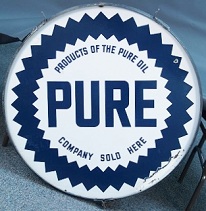
Ohio Cities Gas Company became Pure Oil in 1917.
By producing, refining and selling its products, Pure Oil became the second vertically integrated petroleum company after Standard Oil. Headquartered in a now iconic Chicago skyscraper it built in 1926, the company joined the 100 largest U.S. industrial corporations. It was acquired in 1965 by Union Oil Company of California, now a division of Chevron.

April 9, 1966 – Birthday of Tula’s Golden Driller
A 76-foot statue of an oilfield worker today known as “The Golden Driller” made its debut at the International Petroleum Exposition in Tulsa, Oklahoma. After several refurbishments, the 22-ton statue would contain 2.5 miles of rods and mesh with tons of plaster and concrete — withstanding winds up to 200 mph. A smaller version of Tulsa’s iconic roughneck originally appeared at the 1953 petroleum exposition as a promotion for the Mid-Continent Supply Company of Fort Worth, Texas.
April 10, 1866 – Densmore Brothers patent Railroad Oil Tank Car
James and Amos Densmore of Meadville, Pennsylvania, received a patent for their “Improved Car for Transporting Petroleum,” developed a year earlier in the northwestern Pennsylvania oil regions. Their patent illustrated a simple but sturdy design for securing two re-enforced containers on a typical railroad car.
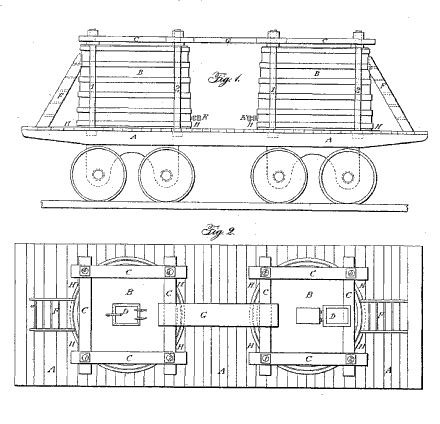
The Densmore oil tank car briefly revolutionized the bulk transportation of oil to market. Hundreds of the twin tank railroad cars were in use by 1866.
Although the Densmore cars were an improvement, they would be replaced by the more practical single, horizontal tank. After leaving the business, Amos Densmore in 1875 invented a new way for arranging “type writing machines” so commonly used letters would no longer collide — the “Q-W-E-R-T-Y” keyboard. James Densmore’s continued success in oilfields helped finance the start of the Densmore Typewriter Company.
Learn more in Densmore Brothers invent First Oil Tank Car.
April 11, 1957 – Oklahoma Independent William Skelly dies
William Grove Skelly (1878 -1957) died in Tulsa after a long career as an independent producer that he began as a 15-year-old tool dresser in early Pennsylvania oilfields. Prior to World War I, he found success in the El Dorado field outside Wichita, Kansas. Skelly incorporated Skelly Oil Company in Tulsa in 1919. Four years later, he established the International Petroleum Exposition while serving as president of the Tulsa Chamber of Commerce. Skelly also helped establish the first FM radio station in Oklahoma, KWGS, in 1947.

April 13, 1974 – Depth Record set in Oklahoma Anadarko Basin
After drilling for 504 days and costing about $7 million, the Bertha Rogers No. 1 well reached a total depth of 31,441 feet (5.95 miles) before being stopped by liquid sulfur. Drilled in the heart of Oklahoma’s Anadarko Basin, it was the deepest well in the world for more than a decade.
Robert Hefner III’s GHK Company and partner Lone Star Producing Company believed natural gas reserves resided deep in the basin, which extends across West-Central Oklahoma and the Texas Panhandle. Their first attempt began in 1967 and took two years to reach what at the time was a record depth of 24,473 feet.
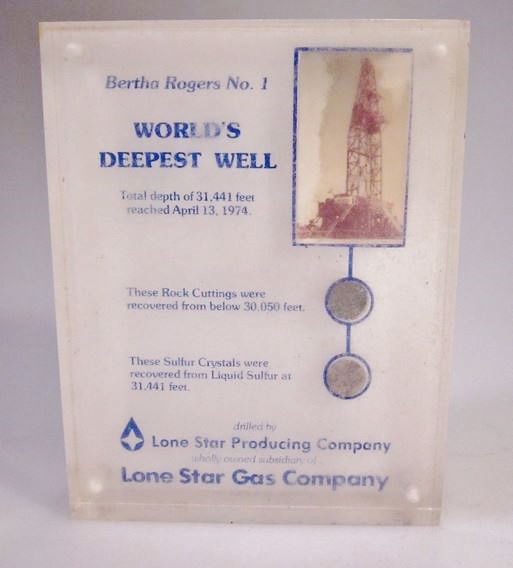
A 1974 souvenir plaque of the Bertha Rogers No. 1 well, which reached almost six miles deep in Oklahoma’s Anadarko Basin.
The high-tech well found plenty of natural gas, according to historian Robert Dorman, but because of federal price controls at the time, “the sale of the gas could not cover the high cost of drilling so deeply – $6.5 million, as opposed to a few hundred thousand dollars for a conventional well.”
Drilling began in November 1972 and averaged about 60 feet per day. By April 1974, bottom-hole pressure reached almost 25,000 pounds per square inch with a temperature of 475 degrees. It took eight hours for cuttings to reach the surface. The well’s 1.5 million pounds of casing was the heaviest ever handled by any drilling rig.
Learn more in Anadarko Basin in Depth.
April 14, 1865 – Dramatic Oil Company’s Failed Oilman turns Assassin
After failing to make his fortune in Pennsylvania oilfields, John Wilkes Booth assassinated President Abraham Lincoln in Washington, D.C. One year earlier, Booth had left his acting career to drill an oil well in booming Venango County.
In January 1864, Booth visited Franklin, Pennsylvania, where he leased 3.5 acres on a farm, about one mile south of the village of Franklin and on the east side of the Allegheny River. With several partners, including his friends from the stage, Booth formed the Dramatic Oil Company and raised money to drill a well.
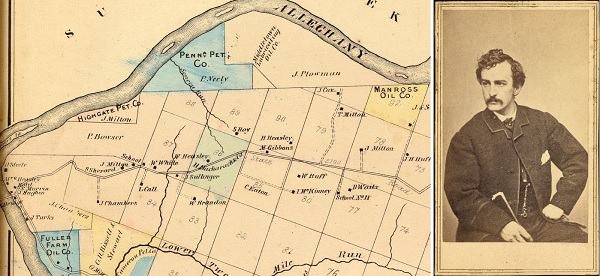
John Wilkes Booth made his first trip to the oil boom town of Franklin, Pennsylvania, in January 1864. He purchased a 3.5-acre lease on the Fuller farm (lower left). Circa 1865 photo of Booth by Alexander Gardner, courtesy Library of Congress.
Although the Dramatic Oil Company’s well found oil and began producing about 25 barrels a day, Booth and his partners wanted more and tried “shooting” the well to increase production. When the well was ruined, the failed oilman left the Pennsylvania oil region for good in July 1864.
Learn more in Dramatic Oil Company.

_______________________
Recommended Reading: The American Railroad Freight Car (1995); Story of the Typewriter, 1873-1923 (2019); Tulsa Oil Capital of the World, Images of America (2004); Oil in Oklahoma
(2004); Oil in Oklahoma (1976); Myth, Legend, Reality: Edwin Laurentine Drake and the Early Oil Industry
(1976); Myth, Legend, Reality: Edwin Laurentine Drake and the Early Oil Industry (2009). Your Amazon purchase benefits the American Oil & Gas Historical Society. As an Amazon Associate, AOGHS earns a commission from qualifying purchases.
(2009). Your Amazon purchase benefits the American Oil & Gas Historical Society. As an Amazon Associate, AOGHS earns a commission from qualifying purchases.
_______________________
The American Oil & Gas Historical Society (AOGHS) preserves U.S. petroleum history. Become an AOGHS annual supporting member and help maintain this energy education website and expand historical research. For more information, contact bawells@aoghs.org. Copyright © 2024 Bruce A. Wells. All rights reserved.






(1959); Oil in Oklahoma
(1976); Textile League Baseball: South Carolina’s Mill Teams, 1880-1955
(2004); The Civil War and Northwestern Virginia
(2004); Conoco: 125 Years of Energy
(2000); Phillips, The First 66 Years
(1983). Your Amazon purchase benefits the American Oil & Gas Historical Society. As an Amazon Associate, AOGHS earns a commission from qualifying purchases.































